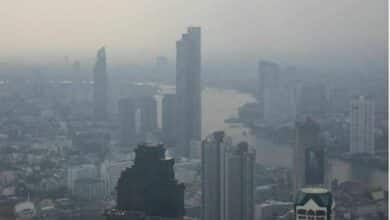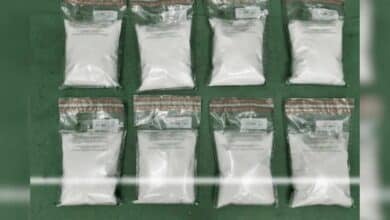World News
World news, global politics, business, technology, and culture—stay updated with breaking stories, international trends, and major events. Get the latest from The Thaiger, your trusted source for global news.
-

Thai Airways slashes baggage limit to 23kg: How it affects you
Passengers flying with Thai Airways will soon have to pack a little lighter, as the airline has announced a reduction in checked baggage allowance for certain Economy Class tickets. Effective April 1, the standard baggage weight for some economy fare classes will be reduced from 25kg to 23kg. The new baggage policy applies to domestic and international flights for passengers…
-

Phumtham denies handpicking pro-govt media for China trip
Deputy Prime Minister and Defence Minister Phumtham Wechayachai has strongly denied allegations that only pro-government media were selected to accompany him on an upcoming trip to China. The visit, set for March 18, aims to check on the 40 Uyghurs deported from Thailand last month, a move that sparked international condemnation. Phumtham’s response comes after People’s Party MP Rangsiman Rome accused…
-

Thai AirAsia offers 30% Songkran discount on direct bookings
Thai AirAsia is offering a 30% discount during the Songkran festival for direct bookings made from March 11 to 20. The airline is supporting the Ministry of Transport’s policy by adding special flights during this peak travel period across five routes from Bangkok (Don Mueang) to Chiang Mai, Chiang Rai, Nakhon Phanom, Udon Thani, and Ubon Ratchathani. The discount applies…
-

Thai Airways bans power banks on flights after explosive fire risk
Airlines worldwide, including Thai Airways, are banning the use and charging of power banks on flights from March 1, following a shocking fire incident aboard a Korean Air Busan flight. The explosion, caused by a faulty power bank, raised serious safety concerns, leading South Korean airlines and other inter6national carriers to tighten regulations to prevent similar disasters. The ban applies…
-

Military drill blunder leaves 4 Thais injured in South Korea
Two fighter planes mistakenly dropped eight bombs in a residential area in South Korea during a military drill between the country and the United States, resulting in 15 injuries. Four of the injured victims are Thai nationals. The spokesperson for the Ministry of Foreign Affairs of Thailand, Nikorndate Palangkul, reported that the ministry received notification of the bombing in Pocheon,…
-

Lufthansa sets sights on Thailand as expansion takes off
The Lufthansa Group is focusing on expanding its operations in Asia and Thailand, while also diversifying into non-airline businesses. Carsten Spohr, chief executive of the group, highlighted that Thailand is not just a tourism hub but also a lucrative business destination. The demand for cargo from Thailand is rising, and the Asia-Pacific region is the fastest-growing market for maintenance, repair,…
-

World’s longest kiss Thai couple split after record-breaking romance
A Thai couple who set the Guinness World Record for the longest kiss have now separated, ending their record-breaking love story more than a decade after their historic smooch. Ekkachai and Laksana Tiranarat became global sensations in 2013 when they locked lips for an astonishing 58 hours and 35 minutes, breaking their own 2011 record of 46 hours and 24…
-

Bangkok Airways suspends northern flights due to smog
Bangkok Airways announced the temporary suspension of all flights between Suvarnabhumi International Airport and the northern destinations of Lampang and Mae Hong Son, as thick smog and hazardous air pollution continue to engulf the region. The airline confirmed that services would be grounded from March 15 to April 20 due to dangerously low visibility caused by persistent haze, which has…
-

Thailand allegedly snubbed US, Canada, Oz, Uyghur asylum offers
Thailand snubbed asylum offers, from the US, Canada, and Australia, and deported 48 ethnic Uyghurs to China, according to Reuters. The move comes despite a decade-long detention limbo and impassioned calls from UN human rights experts for the Uyghurs’ safety. The Government of Thailand staunchly defended the deportation, asserting it was carried out in line with their legal and human…
-

Thai plane shame: Pakistanis stranded in Bangkok bust-up (video)
Chaos erupted for Pakistani travellers after they found themselves marooned in Bangkok for two long days after technical issue with a Thai Airways flight. In a maddening turn of events, passengers were left in suspense for six gruelling hours at Suvarnabhumi International Airport in Bangkok, clinging to the hope of an alternative flight. Those hopes were dashed, however, when Thai…
-

Qatar Airways addresses passenger seated next to dead woman
Qatar Airways issued a statement following an incident where a passenger was seated next to a dead woman for four hours during a flight. The airline emphasised that the crew acted promptly and appropriately, and compensation along with psychological support has been provided. This situation arose from an Australian couple’s account to their local television station, criticising Qatar Airways’ cabin…
-

Labour Ministry backs export of Muay Thai coaches to Hong Kong
The Labour Ministry has committed to fully supporting the export of Muay Thai boxing coaches to Hong Kong, where there is a significant demand for their expertise. This commitment was highlighted during Labour Minister Phiphat Ratchakitprakarn’s recent visit to the territory. During his visit, Phiphat, accompanied by senior ministry officials, toured a fitness centre on Fa Yuen Street in Mong…
-

Phuket Airport to boost flight capacity to 35 per hour
The Thai Ministry of Transport has instructed the Aeronautical Radio of Thailand Company Limited (AEROTHAI) to enhance Phuket Airport’s flight handling capacity. By 2025, the aim is to increase from 25 to 35 flights per hour. Deputy Minister of Transport Monaporn Charernsri announced yesterday, February 27 that AEROTHAI is examining methods to boost Phuket Airport’s efficiency, one of Thailand’s busiest…
-

Thailand deports 40 Uyghurs to China amid global outrage
Thailand has secretly deported 40 Uyghur detainees to China after nearly 11 years in detention, sparking international outrage and accusations of human rights violations. The deportation was confirmed by Defence Minister Phumtham Wechayachai, who stated that the transfer was conducted under international standards and after receiving assurances from China regarding the detainees’ welfare. The operation began in the early hours…
-

Thai Airways reports huge loss but promises strong comeback
Thai Airways International has assured stakeholders that its massive loss for fiscal year 2024 is due to a one-off debt-to-equity conversion and will not hinder its operational performance or planned exit from its rehabilitation programme. The airline reported a staggering loss of 26.901 billion baht, primarily caused by a one-time accounting loss of 45.271 billion baht from the debt-to-equity conversion completed…
-

U-Tapao Airport expansion cut as high-speed rail delays continue
The ambitious U-Tapao Airport expansion is being drastically scaled back as the Bangkok-Rayong high-speed rail project faces ongoing delays and uncertainty. The airport, a key component of the Eastern Economic Corridor (EEC) development, was initially designed to handle 12 million passengers annually. However, with the high-speed rail link stalled for nearly five years, those plans are being significantly downsized. U-Tapao…
-

New horizons: Norse Atlantic soars with Gatwick to Bangkok route
Norse Atlantic Airways announced the launch of a new direct route from London Gatwick to Bangkok, promising passengers an enticing journey without breaking the bank. Set to take off on Sunday, October 26 this year, the new service will operate up to four times a week, with return fares starting from just £295 (12,500 baht) taxes included. The announcement comes…
-

India offers free 30-day visa for Thai tourists until end of the year
To boost Thai tourist arrivals and balance the growing number of Indian tourists visiting Thailand, India is offering Thai travellers a 30-day visa-free entry until the end of 2025. The Indian government announced that Thai visitors could now apply for an e-tourist visa online without paying any entry fee, encouraging more Thais to explore India. The Indian embassy in Thailand…
-

Taiwan warns citizens about visiting Thailand over fraud risks
Taiwan issued a stark warning to its citizens, naming Thailand among five Southeast Asian countries considered high-risk destinations due to their association with fraud rings. The advisory also includes Vietnam, Myanmar, Cambodia, and Laos. According to a Taiwan News report, the Taiwanese Interior Ministry is taking proactive measures to protect its citizens from falling victim to scam operations. Travellers to…
-

Thai Airways aims for top 10 global rank by this year
Chansin Treenuchagron, a key figure in Thai Airways, emphasised the airline’s crucial role in national development while aiming to rank among the top 10 airlines globally. The discussion took place yesterday, February 19 at the Matichon Leadership Forum 2025, held at the Queen Sirikit National Convention Centre in Bangkok. Chansin, a board member and executive planner of Thai Airways International…
-

Bangkok to adopt Beijing’s air pollution solutions in landmark deal
Bangkok is set to benefit from Beijing’s expertise in tackling air pollution, as the two capitals signed a groundbreaking Memorandum of Understanding (MOU) on Air Quality Monitoring and Management Cooperation. The agreement, signed via video between the Beijing Municipal Ecology and Environment Bureau and the Bangkok Metropolitan Administration’s Environment Department, marks a major step in the fight against toxic smog.…
-

THAI flight makes emergency landing as passenger stops breathing
Thai Airways (THAI) flight TG408, en route from Singapore to Suvarnabhumi Airport, issued an emergency signal while flying over the Gulf of Thailand yesterday, February 18. The aircraft landed safely at Suvarnabhumi Airport after the emergency alert was triggered due to a medical situation on board. Reports revealed that the emergency, named TG408/18FEB 77B/TKR SINBKK Declare Medical Emergency Landing, was…
-

Delta Air Lines plane flips at Toronto, eight injured (video)
A Delta Air Lines aircraft flipped onto its back while landing at Toronto Pearson Airport in Canada, resulting in eight injuries. The incident, involving a plane carrying 80 passengers, occurred yesterday, February 17, local time. Video footage showed the Delta Air Lines plane upside down on a snow-covered runway, with passengers gradually exiting the aircraft. Emergency medical personnel at the…
-

Sex sales: China’s sex doll revolution with an AI-morous embrace
In a bold leap forward, China’s WMDoll is shaking up the sex toys industry with its cutting-edge, AI-enhanced creations, promising heightened interactivity and a surge in sex doll sales. With state-of-the-art technology behind the scenes, these sophisticated companions are transforming the market. It’s no secret that life’s little pleasures often come with a twist, and China’s WMDoll is adding quite…
-

Tragic temple fire in New York kills Buddhist monk
A devastating fire tore through a Buddhist temple in The Bronx, New York City, early Wednesday morning, February 12, leaving two people dead, including a Buddhist monk. The blaze, which erupted around 6am, quickly engulfed the small temple and a neighbouring residence for monks, causing irreversible damage. FDNY Chief of Department John Esposito confirmed the tragedy. “We had fire throughout…
-

AirAsia soars to new heights with record passenger growth in 2024
AirAsia is flying high after recording a surge in passenger numbers throughout 2024, as the budget airline group expanded its fleet to meet booming travel demand. The carrier welcomed over 63 million passengers last year, an 11% increase from 2023, while its load factor climbed to 89%. The final quarter of 2024 was particularly strong, with 16.2 million passengers flying…
-

Whale of a tale: Chilean kayaker swallowed by humpback (video)
In a heart-stopping incident off Chilean Patagonia, a kayaker found himself briefly swallowed by a humpback whale before being miraculously released unharmed. The jaw-dropping event was caught on camera and rapidly swept through social media, captivating viewers worldwide. Last Saturday, adventurer Adrian Simancas was enjoying a day of kayaking with his father, Dell, in Bahía El Aguila, near the San…
-

Bangkok passenger caught smuggling ‘space oil’ at HK airport
A brazen drug smuggler’s trip from Bangkok to Hong Kong ended in disaster when customs officers uncovered a shocking stash of illicit “space oil” hidden in fruit-flavoured drink powder. The 22 year old suspect was stopped at Hong Kong International Airport yesterday, February 13, where officials discovered approximately 8 kilogrammes of the substance, containing the controlled drug etomidate, inside his…
-

Ex-minister’s son pulled off Bangkok flight over ‘kidnapping’ alert
A chartered flight carrying India’s former Maharashtra minister Tanaji Sawant’s son, Rishiraj Sawant, and two friends was recalled to Pune under extraordinary circumstances. Police ordered the abrupt diversion after an anonymous tip-off claimed Rishiraj had been kidnapped, triggering an urgent police response. The private jet, which took off for Bangkok on Monday, February 10, was redirected after aviation officials verified…
-

Brit arrested at Manchester Airport for drug offences after Thai trip
A 21 year old British man’s holiday ended in handcuffs after he was arrested at Manchester Airport upon returning home from Thailand. Matthew Crehan, of Dentons Green Lane, St Helens, was taken into custody on Saturday, February 8, before being charged with multiple drug supply offences. Merseyside Police confirmed that Crehan faces charges related to the supply of class A,…
Broke? Find employment in Southeast Asia with JobCute Thailand and SmartJob Indonesia. Rich? Invest in real estate across Asia with FazWaz Property Group or get out on a yacht anywhere with Boatcrowd. Even book medical procedures worldwide with MyMediTravel, all powered by DB Ventures.





























